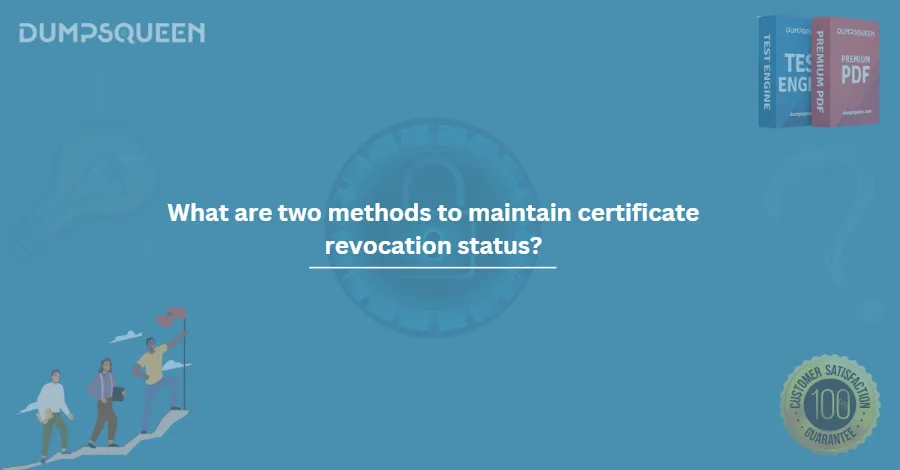Certificate Revocation in Cybersecurity: Mastering the Basics with DumpsQueen
In the ever-evolving world of cybersecurity, staying ahead of threats requires not just knowledge but also the right tools and resources. One critical concept that every aspiring cybersecurity professional must grasp is certificate revocation—a cornerstone of secure digital communication. Whether you’re preparing for the CompTIA Security+ SY0-701 exam or simply aiming to deepen your understanding, mastering certificate revocation can set you apart. And when it comes to acing this topic (and the exam), DumpsQueen stands out as an invaluable ally. In this blog, we’ll explore certificate revocation, break down its primary methods, compare CRL and OCSP, and share expert exam tips—all tailored to help you succeed with DumpsQueen by your side.
Brief Overview of Certificate Revocation in Cybersecurity
Imagine a world where every digital handshake—every secure connection between your browser and a website—relies on trust. That trust is built on digital certificates, issued by Certificate Authorities (CAs), which verify the identity of websites, servers, and users. But what happens when that trust is compromised? What if a certificate is stolen, misused, or no longer valid? That’s where certificate revocation comes in.
Certificate revocation is the process of invalidating a digital certificate before its scheduled expiration date. It’s a critical mechanism in cybersecurity, ensuring that compromised or untrustworthy certificates can’t be used to deceive systems or users. Think of it as a “do not trust” list for the digital world. Without it, attackers could exploit revoked certificates to launch phishing attacks, intercept sensitive data, or impersonate legitimate entities.
For students and professionals preparing for certifications like CompTIA Security+ SY0-701, understanding certificate revocation isn’t just academic—it’s practical. It’s about knowing how systems maintain security in real-world scenarios. And with resources like DumpsQueen, you can dive into this topic with confidence, gaining the clarity and practice needed to excel.
Understanding Certificate Revocation
At its core, certificate revocation is about maintaining the integrity of Public Key Infrastructure (PKI), the framework that governs digital certificates. When a certificate is issued, it’s assumed to be trustworthy for its entire validity period—often one to two years. But circumstances change. A private key might be compromised, an organization might cease operations, or a certificate might be issued in error. When this happens, the CA revokes the certificate, signaling to all relying parties (browsers, servers, etc.) that it’s no longer valid.
Revocation isn’t automatic—it requires a system to communicate and check the status of certificates. This is where things get interesting (and a little complex). The CA must maintain an up-to-date record of revoked certificates and make that information accessible. Meanwhile, systems relying on certificates must actively verify their status before establishing trust. If this process fails, security collapses.
For anyone studying cybersecurity, this is where foundational knowledge meets real-world application. The SY0-701 exam, for instance, tests your ability to understand and apply concepts like this. With DumpsQueen expertly curated materials, you’re not just memorizing facts—you’re learning how certificate revocation works in practice, from the CA’s role to the end-user impact.
Two Primary Methods to Maintain Certificate Revocation Status
So, how do systems check if a certificate has been revoked? There are two primary methods: Certificate Revocation Lists (CRLs) and Online Certificate Status Protocol (OCSP). Both serve the same purpose—verifying certificate validity—but they approach it differently. Let’s break them down.
Certificate Revocation Lists (CRLs)
A CRL is essentially a blacklist—a list of serial numbers of revoked certificates, published periodically by the CA. Think of it as a “wanted poster” for certificates that can no longer be trusted. The CA signs the CRL to ensure its authenticity, and systems download it to check against the certificates they encounter.
- How it works: When a system (like a browser) receives a certificate, it checks the CRL’s distribution point (a URL embedded in the certificate), downloads the latest list, and searches for the certificate’s serial number. If it’s on the list, the certificate is rejected.
- Pros: CRLs are simple and widely supported. They don’t require real-time communication with the CA beyond downloading the list.
- Cons: CRLs can grow large over time, especially for CAs managing millions of certificates. They’re also only as current as their last update—typically every 24 hours or more—which leaves a window of vulnerability.
Online Certificate Status Protocol (OCSP)
OCSP takes a more dynamic approach. Instead of downloading a full list, systems query the CA’s OCSP server in real time to check a specific certificate’s status. The server responds with “good,” “revoked,” or “unknown.”
- How it works: When a certificate is presented, the relying party sends an OCSP request to the CA’s server (another URL in the certificate). The server checks its records and sends back a signed response.
- Pros: OCSP provides up-to-the-minute status, reducing the risk of accepting a recently revoked certificate. It’s also lighter than downloading a massive CRL.
- Cons: It requires constant connectivity to the OCSP server, which can introduce latency or fail if the server is down. Privacy concerns also arise, as the CA can track which certificates are being checked.
Both methods are critical to PKI, and understanding their mechanics is key to mastering SY0-701. DumpsQueen practice questions and detailed explanations make it easy to grasp these concepts, ensuring you’re ready for any exam scenario.
CRL vs. OCSP – Key Differences
While CRL and OCSP aim to solve the same problem, their differences matter—both in practice and on the exam. Here’s a head-to-head comparison to clarify things:
1) Timeliness
CRL: Updated periodically (e.g., daily or weekly). A certificate revoked right after an update won’t appear until the next one, creating a potential security gap.
OCSP: Real-time status checks mean immediate awareness of revocations, offering tighter security.
2) Scalability
CRL: As the number of revoked certificates grows, CRLs become unwieldy, slowing down systems that need to process them.
OCSP: Scales better for individual checks but can overwhelm OCSP servers under heavy traffic.
3) Bandwidth and Performance
CRL: Downloading a full list (sometimes megabytes in size) can strain bandwidth, especially on low-resource devices.
OCSP: Smaller, targeted requests save bandwidth but add latency due to server queries.
4) Reliability
CRL: Works offline once downloaded, making it more resilient to network issues.
OCSP: Depends on a live connection to the OCSP server—if it’s unreachable, systems may default to accepting the certificate (a risky move).
5) Privacy
CRL: No one knows which certificates you’re checking; you just have the list.
OCSP: The CA sees every query, potentially tracking user activity unless mitigated (e.g., with OCSP stapling).
For SY0-701, you’ll need to know these distinctions cold. Questions might ask you to identify the best method for a given scenario—like choosing OCSP for a high-security environment or CRL for a resource-constrained one. DumpsQueen resources shine here, offering scenario-based practice that mirrors the exam’s real-world focus.
Exam Tips for SY0-701
Preparing for the CompTIA Security+ SY0-701 exam can feel daunting, but with the right approach—and DumpsQueen—you’ll walk in confident. Certificate revocation is just one piece of the puzzle, but it’s a great example of the technical depth the exam demands. Here are some tailored tips to ace it:
1) Master the Basics First
Before diving into CRL vs. OCSP, ensure you understand why revocation matters. DumpsQueen foundational lessons break it down into digestible chunks, building your knowledge step-by-step.
2) Practice Scenarios
The SY0-701 loves situational questions. Will a slow CRL update compromise a bank’s security? Does OCSP latency matter for an IoT device? DumpsQueen practice tests simulate these scenarios, helping you think like an examiner.
3) Memorize Key Terms
Know your acronyms—CRL, OCSP, CA, PKI—and what they mean. DumpsQueen flashcards and quick-reference guides are perfect for drilling these into memory.
4) Understand Trade-Offs
CRL and OCSP aren’t “better” or “worse”—they’re situational. Study their pros and cons (like those above) and practice applying them. DumpsQueen detailed explanations clarify when to choose one over the other.
5) Time Management
The exam 90 minutes fly by. Practice with DumpsQueen timed quizzes to get comfortable answering technical questions quickly and accurately.
6) Leverage DumpsQueen Community
Stuck on a concept? DumpsQueen often pairs its materials with forums or support, letting you tap into a network of learners and experts for clarification.
With DumpsQueen, you’re not just studying—you’re strategizing. Its comprehensive resources align perfectly with SY0-701’s objectives, giving you an edge over generic study guides.
Conclusion
Certificate revocation might seem like a small cog in the vast machine of cybersecurity, but it’s a vital one. By understanding how CRL and OCSP maintain trust in digital certificates, you’re equipping yourself to tackle real-world challenges—and the SY0-701 exam. Whether it’s the periodic updates of CRLs or the real-time precision of OCSP, each method plays a role in securing our digital lives.
For anyone aiming to conquer Security+, DumpsQueen is more than a resource—it’s a partner. Its tailored content, practice tools, and exam-focused approach make complex topics like certificate revocation accessible and actionable. As you prepare, let DumpsQueen guide you through the nuances of PKI, the trade-offs of revocation methods, and the strategies to succeed. With the right knowledge and the best tools, you’re not just passing an exam—you’re building a foundation for a thriving cybersecurity career.
Free Sample Questions
Which of the following are standard methods to maintain certificate revocation status?
A. DNS and DHCP
B. CRL and OCSP
C. SSL and TLS
D. HTTPS and FTPS
Correct Answer: B. CRL and OCSP
What does OCSP stand for in the context of certificate revocation?
A. Online Certificate Status Protocol
B. Open Certificate Security Protocol
C. Operational Certificate Signing Policy
D. Official Certification Security Process
Correct Answer: A. Online Certificate Status Protocol
Which of the following statements about CRLs is TRUE?
A. CRLs are updated in real time for instant revocation checking.
B. CRLs are a list of certificates that have been permanently renewed.
C. CRLs are downloaded periodically and may not be real-time.
D. CRLs are only used in email encryption.
Correct Answer: C. CRLs are downloaded periodically and may not be real-time.
One drawback of using Certificate Revocation Lists (CRLs) is:
A. They require advanced biometric verification.
B. They may become large and slow to download.
C. They offer real-time validation.
D. They are incompatible with all browsers.
Correct Answer: B. They may become large and slow to download.
Why might an organization prefer OCSP over CRL for revocation status?
A. OCSP provides certificate renewal services.
B. OCSP requires no network connectivity.
C. OCSP provides faster, real-time responses.
D. OCSP does not need a CA to function.
Correct Answer: C. OCSP provides faster, real-time responses.




